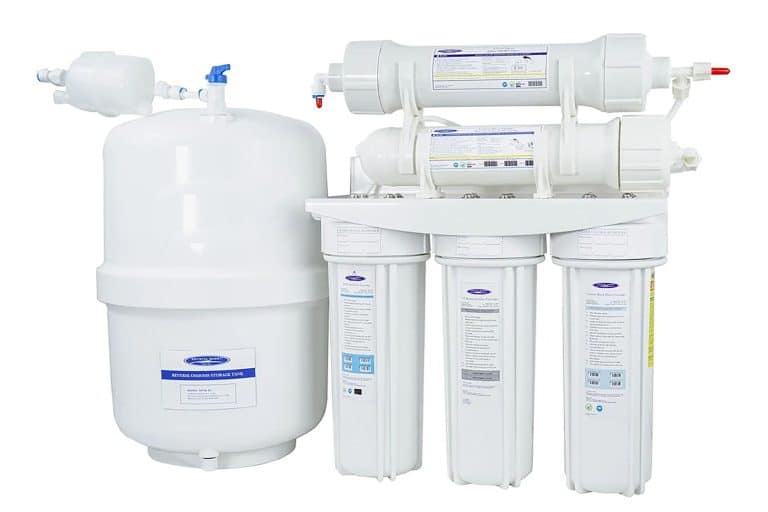Reverse osmosis (RO) is a water purification process that uses a semipermeable membrane to remove ions, molecules, and larger particles from drinking water. It is a proven technique for producing the best quality of drinking water and is suitable for home and office use. In this guide, we will discover the reverse osmosis filter system, its advantages, maintenance needs, and other things.
What Is The Process Of A Reverse Osmosis Filter System?
A reverse osmosis filtering system works by exerting pressure on water to force it through a semipermeable membrane that allows only pure water molecules to pass through while contaminants are left behind. The membrane usually has small pores, only large enough for water molecules to get through, thus filtering out impurities like dissolved salts, minerals, and organic compounds.
The process comprises several stages of filtration, such as sediment filtration, carbon filtration, and the reverse osmosis membrane itself. Each phase removes a particular type of contaminant. Thus, the water is purified.
What Are The Advantages Of A Reverse Osmosis Filter System?
- Removes Contaminants: RO systems are capable of eliminating the majority of the contaminants, such as lead, arsenic, fluoride, chlorine, and bacteria, giving access to clean and safe water for drinking.
- Improves Water Taste: By removing impurities, RO systems can improve the taste and odor of the water you drink, thus making it more appealing to drink.
- Cost-Effective: In the beginning, the cost of an RO system may be higher than other filtration methods, but in the long run, it can be more cost-effective because it eliminates the need for bottled water.
- Environmentally Friendly: With the use of an RO system, the plastic waste from bottled water is reduced, making it a more environment-friendly option.
- Easy to Maintain: RO systems have a low maintenance level, the only obligation being the replacement of filters to keep the system running at its best.
What Contaminants Can A Reverse Osmosis Filter System Remove?
- Dissolved salts: e. g. sodium, chloride, and sulfate.
- Heavy metals, such as lead, arsenic, and mercury.
- Chemical contaminants like chlorine, pesticides, and herbicides.
- Microorganisms: comprising bacteria, viruses, and protozoa.
What Maintenance A Reverse Osmosis Filter System Needs?
- Replacing Filters: The pre-filter, post-filter, and membrane should be replaced regularly as recommended by the manufacturer so that the system can continue to work efficiently.
- Sanitizing The System: Scheduled cleaning of the system to remove any bacteria or algae accumulation that may affect the quality of the water.
- Checking For Leaks: Inspect the system periodically for any leaks or damage that could develop over time.
Is A Reverse Osmosis Filter System Able To Enhance Water Taste?
Indeed, a reverse osmosis filter system can make a great difference in the taste and smell of your drinking water by removing impurities that might make it taste bad. Many of the users of the RO system feel that the water from the RO system tastes cleaner and fresher than tap water without treatment.
Are Reverse Osmosis Filter Systems Environmentally Friendly?
Although the reverse osmosis filter systems are friendly to the environment as they reduce plastic waste from bottled water. They do require minimal electricity to run, which in turn contributes to the popularity of the RO system among responsible buyers. Nevertheless, the RO system’s overall environmental impact is usually lower than that of bottled water.
How Long Do Reverse Osmosis Filter Systems Last?
The lifespan of a reverse osmosis system varies depending on different factors, such as the quality of the system, water quality, and how well it is maintained. When it comes to service, an RO system can last for many years before it needs to be replaced, provided that it is properly maintained.
Can A RO Filter System Reduce Fluoride In Water?
Indeed, a reverse osmosis filter system is very efficient in removing fluoride as well as other contaminants from water. The RO membrane can efficiently remove fluoride molecules and produce water free of this chemical.
How Frequently Should You Change The Filters In An RO System?
The frequency of filter replacement in a reverse osmosis system depends on the quality of the water and the volume of water filtered. In general, the pre-filter and post-filter should be replaced every 6-12 months, while the membrane should be replaced every 2-3 years or as the manufacturer recommends.
Final Words!
An RO filter system is a reliable way of producing clean, safe drinking water. By learning how these systems function and taking care of them properly, you can ensure that the water is always free from contaminants and safe for drinking.

